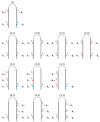Photon entanglement signatures in difference-frequency-generation
- PMID: 19158927
- PMCID: PMC2895415
- DOI: 10.1364/oe.17.001093
Photon entanglement signatures in difference-frequency-generation
Abstract
In response to quantum optical fields, pairs of molecules generate coherent nonlinear spectroscopy signals. Homodyne signals are given by sums over terms each being a product of Liouville space pathways of the pair of molecules times the corresponding optical field correlation function. For classical fields all field correlation functions may be factorized and become identical products of field amplitudes. The signal is then given by the absolute square of a susceptibility which in turn is a sum over pathways of a single molecule. The molecular pathways of different molecules in the pair are uncorrelated in this case (each path of a given molecule can be accompanied by any path of the other). However, entangled photons create an entanglement between the molecular pathways.We use the superoperator nonequlibrium Green's functions formalism to demonstrate the signatures of this pathway-entanglement in the difference frequency generation signal. Comparison is made with an analogous incoherent two-photon fluorescence signal.
Figures






Similar articles
-
A unified description of sum frequency generation, parametric down conversion and two-photon fluorescence.Mol Phys. 2009 Oct 1;107(3):265-280. doi: 10.1080/00268970902824250. Mol Phys. 2009. PMID: 20607143 Free PMC article.
-
Multidimensional pump-probe spectroscopy with entangled twin-photon states.Phys Rev A. 2009 Jan 1;79(6):63409. doi: 10.1103/PhysRevA.79.063409. Phys Rev A. 2009. PMID: 20607106 Free PMC article.
-
Nonlinear spectroscopy with entangled photons; manipulating quantum pathways of matter.Phys Rev A. 2009 Mar 1;79(3):33832. doi: 10.1103/PhysRevA.79.033832. Phys Rev A. 2009. PMID: 20613885 Free PMC article.
-
Coherent (photon) vs incoherent (current) detection of multidimensional optical signals from single molecules in open junctions.J Chem Phys. 2015 Jun 7;142(21):212445. doi: 10.1063/1.4919955. J Chem Phys. 2015. PMID: 26049465
-
Nonlinear light scattering in molecules triggered by an impulsive X-ray Raman process.Phys Rev A. 2013 May 1;87(5):53826. doi: 10.1103/PhysRevA.87.053826. Phys Rev A. 2013. PMID: 24465122 Free PMC article.
Cited by
-
A unified description of sum frequency generation, parametric down conversion and two-photon fluorescence.Mol Phys. 2009 Oct 1;107(3):265-280. doi: 10.1080/00268970902824250. Mol Phys. 2009. PMID: 20607143 Free PMC article.
-
Multidimensional pump-probe spectroscopy with entangled twin-photon states.Phys Rev A. 2009 Jan 1;79(6):63409. doi: 10.1103/PhysRevA.79.063409. Phys Rev A. 2009. PMID: 20607106 Free PMC article.
-
Exciton dressing by extreme nonlinear magnons in a layered semiconductor.Nat Nanotechnol. 2025 May;20(5):617-622. doi: 10.1038/s41565-025-01890-8. Epub 2025 Mar 17. Nat Nanotechnol. 2025. PMID: 40097650
References
-
- Turchette QA, Wood CS, King BE, Myatt CJ, Leibfried D, Itano WM, Monroe C, Wineland DJ. Deterministic Entanglement of Two Trapped Ions. Phys Rev Lett. 1998;81:3631.
-
- Walther P, Pan J, Aspelmeyer M, Ursin R, Gasparoni S, Zeilinger A. De Broglie wavelength of a nonlocal four-photon state. Nature. 2004;429:158. - PubMed
-
- Javanainen J, Gould P. Linear intensity dependence of a two-photon transition rate. Phys Rev A. 1990;41:5088. - PubMed
-
- Dayan B. Theory of two-photon interactions with broadband down-converted light and entangled photons. Phys Rev A. 2007;76:43813.
-
- Lee D, Goodson T. Entangled Photon Absorption in an Organic Porphyrin Dendrimer. J Phys Chem B. 2006;110:25582. - PubMed

